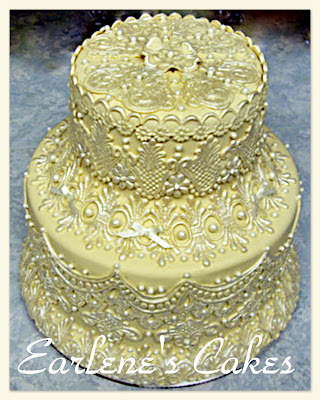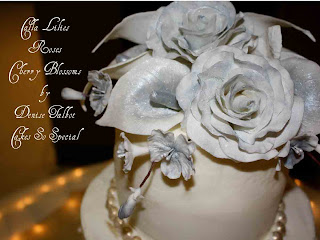~filling (buttercream or ganache type suggested)
~Fondant
~sugarcraft gun
~gumpaste
~luster dust
~cake board or foamcore
~serrated knife
~offset spatula
INSTRUCTIONS
When making any purse cake (replicating a real purse) I search for images of the purse, including the purse name and the dimensions. the LV Speedy 25 is around 10"x7"x6". Measurements are good to know so that if you need to rescale the purse smaller (or larger) it can still be proportionate to the original.
This particular cake was made to the actual size of the purse.I baked 3 of the half sheet cakes. I cut the cakes into strips 6 inches wide by 10, so about 3 strips per cake. you can either make sure you have enough full strips for the entire cake, or you can use the bigger scrap type pieces in the middle layers.
I cut 2 pieces of cake board. The bigger one for the bottom, it measured slightly smaller than the size of the cake, mainly because purses tend to have a curve on the bottom. the other board can be cut to the same size for this purse, but I usually cut slightly smaller for ease of carving.I placed my strips of cake and icing between them just as if icing a cake, however after my 3rd layer of cake, I place straws or dowels in the center, just 3 for this size cake, and then smear a little icing.
On top of the dowels, I place my second cardboard. I then finish layering my cake. Once done, you have just a rectangle of cake and icing.
The filling isn't very thick, just about 1/4 inch. I don't recommend using a slippery filling when carving/sculpting any cake.Chill the cake until it has firmed up and is ready to carve, depending on the cake, this time could vary.
At this point, I actually had a photo of the end of the purse, enlarged to the size I wanted the cake to be.
I used this as a template to carve my cake. If you are are in touch with your artistic side that day, you can wing it! When carving, I carved a straight line down the center of the first layer of cake, to indicate where the center was then I carved each side.. I learned that tip from Mike McCary's DVD ( He's one of my cake idols.. I have quite a few!!!)
At this point, I actually had a photo of the end of the purse, enlarged to the size I wanted the cake to be.
I used this as a template to carve my cake. If you are are in touch with your artistic side that day, you can wing it! When carving, I carved a straight line down the center of the first layer of cake, to indicate where the center was then I carved each side.. I learned that tip from Mike McCary's DVD ( He's one of my cake idols.. I have quite a few!!!)

Anywhoo..... once the cake was carved into the shape of the purse:
I covered it in buttercream and then chilled it again..From here on, I don't have any pics in process (sorry!) but here is what I did.
~make a zipper using a long rectangle strip.
I have seen many ways to make a zipper: using a mold, marking with a paring knife, or using the side of a jar to make the lines. Color the zipper portion gold and lay it on the top of the bag.(this is important to do first because I forgot and had to lift up my sides to fit the zipper in.. NOT FUN!!~make a zipper using a long rectangle strip.
~roll out fondant in rectangles, to cover the sides and ends.
I do this one piece at a time so the fondant doesn't dry. I roll out the longer sides first, but I'm sure it doesn't matter. Place the fondant up against the side you are covering and trim along the edge of the purse with a very sharp knife, xacto knife or razor, but make sure it's sharp so you can cut with a sliding motion, instead of a sawing motion. trim along the bottom, leaving just a little bit of excess so you can use a dogbone tool to push it under the cake. For the longer sides trim along the sides of the zipper you placed on the top. Do the same procedure for the remaining 3 sides.~If you have an airbrush, this is the point where you would airbrush your cake.
You can airbrush from white to brown, or you can start with beige or brown fondant and airbrush from there. If you don't have an airbrush, I suggest using chocolate fondant. I personally HATE coloring fondant brown..
You can airbrush from white to brown, or you can start with beige or brown fondant and airbrush from there. If you don't have an airbrush, I suggest using chocolate fondant. I personally HATE coloring fondant brown..
~check your photos to see if any details are under the seams.
On this purse, it looked like the little tab on the end was under the seam, so I cut that out and applied it before I did the seam.~once all 4 surfaces are covered, soften some fondant with shortening and use your extruder with the round opening to make strips. glue these lines to the edges where they join, you can use water, but I like to use tylose glue. (tylose powder with water added) I try to make one long piece to cover, but if not, you can smooth the seams with some water and a palette knife or offset spatula
On this purse, it looked like the little tab on the end was under the seam, so I cut that out and applied it before I did the seam.~once all 4 surfaces are covered, soften some fondant with shortening and use your extruder with the round opening to make strips. glue these lines to the edges where they join, you can use water, but I like to use tylose glue. (tylose powder with water added) I try to make one long piece to cover, but if not, you can smooth the seams with some water and a palette knife or offset spatula
~LV has a very specific pattern.
On this cake, my emblems are larger than they would be on a purse, but I tried to stick to the pattern, except in the spot where I got off.. hey every cake has a back right??!! I hand painted these emblems on with gold luster and lemon extract. there are also cutters that are similar to the shapes. using and edible image is also an option. This is part where you can get creative. Sometimes we like items to look like exact replicas, but I have come to realize that it is an ARTISTIC REPRESENTATION, and therefore does not have to be exact. I'm sticking to it!
On this cake, my emblems are larger than they would be on a purse, but I tried to stick to the pattern, except in the spot where I got off.. hey every cake has a back right??!! I hand painted these emblems on with gold luster and lemon extract. there are also cutters that are similar to the shapes. using and edible image is also an option. This is part where you can get creative. Sometimes we like items to look like exact replicas, but I have come to realize that it is an ARTISTIC REPRESENTATION, and therefore does not have to be exact. I'm sticking to it!

~if you notice on this bag,
the handles aren't at the top of the bag, so while I'm sure it would be possible to make hard handles standing up, I felt like it would be easier to make them hanging down. If you wanted to do them standing up, I would suggest gumpaste handles made in advance of course. Elisa Strauss has instructions on how to do handles in her confetti cakes book. and I'm sure you could google.. google is my friend when making cake! So for these handles, I first made the shapes of the leather patches that are stitched on the bag. for the gold metal circle, I just cut a circle of fondant with a round tip and painted it gold. I made the handle with a rectangle folded in half and stitched on the edge.
the handles aren't at the top of the bag, so while I'm sure it would be possible to make hard handles standing up, I felt like it would be easier to make them hanging down. If you wanted to do them standing up, I would suggest gumpaste handles made in advance of course. Elisa Strauss has instructions on how to do handles in her confetti cakes book. and I'm sure you could google.. google is my friend when making cake! So for these handles, I first made the shapes of the leather patches that are stitched on the bag. for the gold metal circle, I just cut a circle of fondant with a round tip and painted it gold. I made the handle with a rectangle folded in half and stitched on the edge.
These handles also have a distinct way they come together over the hardware so to replicate that I made the end of the handle fold over where the hardware would be and stitched it. I glued the handle to the leather patches. Because the handles are not standing up, the hardware is just an illusion. I made 2 thin sausage shapes out of modeling chocolate and stuck the ends in the opening on the patch and the opening in the handle. I then painted them gold
.~make any other hardware that comes on the purse that you want to make. and voila! a purse!
.~make any other hardware that comes on the purse that you want to make. and voila! a purse!
here is another LV purse I made, different shape, pretty much the same procedure
Photos and Tutorial by Samele Thorner 2009. All rights reserved.
The tutorial or patterns cannot be reproduced for commercial purposes without permission from the author.




 Make the pistils in advance and let dry. Roll a small sausage about the 2/3 the length of your cutter. If you are making natural looking calla's start with yellow paste. I use long toothpicks and insert after dipping the end in piping gel. After they are dry, brush them with a thin coat of piping gel and roll them in a little bit of massa cornmeal for a realistic look.
Make the pistils in advance and let dry. Roll a small sausage about the 2/3 the length of your cutter. If you are making natural looking calla's start with yellow paste. I use long toothpicks and insert after dipping the end in piping gel. After they are dry, brush them with a thin coat of piping gel and roll them in a little bit of massa cornmeal for a realistic look.






 If you check out my website (
If you check out my website (  Find the method you like best to make your own callas.
Find the method you like best to make your own callas.






























